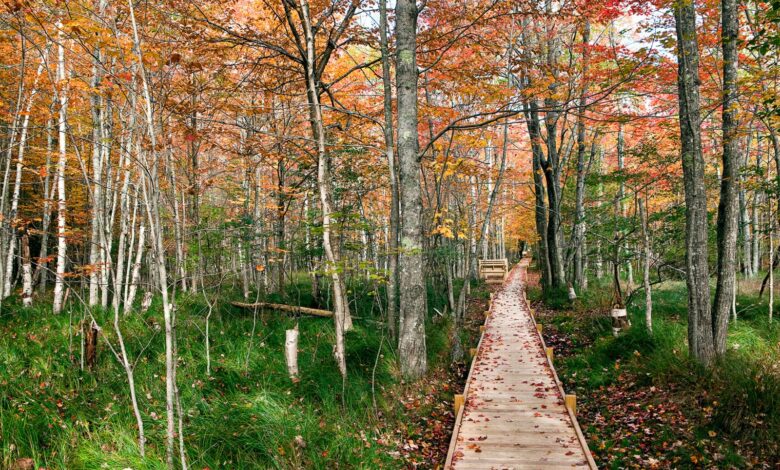The best national parks in the United States – The Points Guy

The stunning landscapes of our national parklands range from parched deserts with Seussian-like trees to marshy coastal waterways.
During the pandemic, as many people sought solace in the wide-open spaces, we were reminded of just how much there is to see without leaving the country.
Of course, the popularity of national parks isn’t expected to wane any time soon. As flight and hotel prices have soared over recent months, travelers continue to seek outdoor getaways closer to home.
In 2022, the National Park Service reported 312 million recreation visits, a 5% increase from 2021. Most parks have now eliminated advance ticket requirements introduced during the pandemic. However, some national parks still place limitations on entry, whether that be timed entry reservations, permits for the most popular trails, or tickets for phenomena such as Yosemite’s optical illusion “firefall.“
So, before booking your national park getaway this year, check for any new requirements and confirm availability.
If you’re eager to steer clear of crowds, remember there are hundreds of sites in the National Park System, including historic battlefields, monuments, rivers and parkways. However, the 63 national parks are among the country’s most exceptional and beautiful centerpieces — and these are 20 of our favorites.
Yellowstone National Park
Why visit: It’s home to over half of the world’s hydrothermal features.
Don’t miss: Rainbow-hued Grand Prismatic Spring, the third-largest hot spring in the world.
How to get there: Yellowstone Airport (WYS), Jackson Hole Airport (JAC) and Bozeman Yellowstone International Airport (BZN) are three of the closest airports.
The legacy of the National Park Service began when the country’s first national park was designated in 1872.
This geologically unique landscape is largely in Wyoming but also stretches into Montana and Idaho. The park’s 2.2 million acres are home to an array of wildlife, including bison, mountain goats and elk, and feature gurgling geysers, steaming hot springs and mountains. Approximately 4 million visitors visit this incredibly popular national park annually to witness its natural wonders.
Sign up for our daily newsletter
Acadia National Park
Why visit: Granite cliffs, cobalt waters, mist-shrouded beaches — the beauty of Maine’s wilderness comes together in Acadia National Park.
Don’t miss: A sunrise hike to the top of the 1,529-foot Cadillac Mountain — the highest point on the North Atlantic seaboard.
How to get there: Hancock County-Bar Harbor Airport (BHB) is just around the corner from the park. You must first fly to Boston Logan International Airport (BOS) and connect on Cape Air or Silver Airways.
Rocky coastlines and windswept beaches converge with rugged, trail-laced woodlands at Acadia National Park in Maine. Depending on the time of year, the highest point along the North Atlantic seaboard, Cadillac Mountain, is often one of the first places in the country to see sunlight at daybreak.
Shenandoah National Park
Why visit: Stunning fall foliage, which usually peaks in late October or early November.
Don’t miss: The 105-mile-long Skyline Drive, famed for its 69 spectacular overlooks and recreational activities.
How to get there: Travelers can fly into any major D.C.-area airport, including Washington Dulles International (IAD) and Ronald Reagan Washington National (DCA).
Easily accessible from Washington, D.C., this 200,000-acre park in Virginia is ideal for scenic drives (including the Blue Ridge Parkway, which connects Shenandoah with the Great Smoky Mountains, and Skyline Drive, which bisects the park). Travelers also flock here for picturesque hikes, including the Appalachian Trail.
White Sands National Park
Why visit: Sculpted wave-like dunes of gypsum sand sparkling in the sun.
Don’t miss: Sand sledding down towering dunes.
How to get there: The closest airport is El Paso International Airport (ELP), about 85 miles south of the park.
This 275-square-mile stretch of desert is punctuated by glistening white gypsum dunes that can be seen from space. Located in New Mexico’s Tularosa Basin, the towering drifts of sand attract travelers who come to hike and sled on the lunar-like terrain.
Grand Teton National Park
Why visit: An outdoor lover’s paradise known for mountaineering, hiking, camping, kayaking, canoeing and winter snow sports.
Don’t miss: Hiking the 7-mile-long Jenny Lake Trail.
How to get there: Jackson Hole Airport (JAC) is located inside Grand Teton National Park, making it the obvious gateway for travelers from out of state.
Wyoming’s Teton Range is one of the most striking landscapes in the country, with alpine scenery you might say is the country’s answer to the Italian Dolomites. The hiking here is exceptional, as are fishing and boating on the Snake River. Best of all, you can bed down in the comfort of the Western mountain town of Jackson Hole and use points for a stay at The Cloudveil, a Marriott Autograph Collection property.
Everglades National Park
Why visit: The U.S.’s largest subtropical wetlands, the Everglades, is an ecological treasure.
Don’t miss: The Anhinga Trail, where you’re pretty much guaranteed to see the park’s brooding denizens — alligators, turtles, otters, herons and exotic birds.
How to get there: Everglades National Park is an easy drive southwest of Miami, so you’ll probably fly into Miami International Airport (MIA).
A rare ecosystem that supports elusive and endangered species like the Florida panther, American crocodile, West Indian manatee and leatherback turtles, the Florida Everglades cover a staggering 1.5 million acres. This wetland is essentially a slow-moving river blanketed in sawgrass, and you’ll want to explore on a flat-bottomed airboat that can coast on top of the water.
Yosemite National Park
Why visit: Stunning landscapes, abundant wildlife and epic hiking opportunities.
Don’t miss: The granite monoliths of Half Dome and El Capitan, the 650-foot Bridalveil waterfall and North America’s tallest waterfall, Yosemite Falls.
How to get there: Expect to spend an hour or more in the car to get to Yosemite. The closest major airports are Fresno Yosemite International (FAT), Oakland International (OAK) and Sacramento International (SMF).
Famous for its imposing granite monoliths, incredible waterfalls and glacier-carved valleys, Yosemite National Park in California is one of the most famous and instantly recognizable national parks in the country. Avoid the crowds by heading into the high country or visiting the more popular recreation areas during the week.
Denali National Park
Why visit: An adventure seeker’s paradise, Denali has some of the best wilderness hikes, wildlife encounters and dramatic landscapes in the nation.
Don’t miss: Hike off-trail on the Toklat East Bench and keep watch for caribou and bears.
How to get there: Fairbanks International Airport (FAI) is the gateway to Denali National Park.
Escape to one of the most untamed stretches of wilderness left in the country, crowned by Denali, the tallest peak in North America. This ancient land in Alaska is where travelers go to see moose, grizzly bears, caribou, Dall sheep and wolves; watch for shimmers of the aurora borealis and experience a world that is still remote enough to feel undiscovered.
Joshua Tree National Park
Why visit: This intricate desert ecosystem harbors a mesmerizing array of flora, sculpted rock formations and evocative remnants that stand testament to 5,000 years of human history.
Don’t miss: Incredible stargazing and, for climbers, colossal boulders to scale.
How to get there: Palm Springs International (PSP) is the closest airport to Joshua Tree, though most people visit from Los Angeles or San Diego.
At the intersection of the Mojave and Colorado deserts in Southern California, Joshua Tree National Park is best known for its massive boulders and fanciful yucca plants: the namesake Joshua trees. Travelers should remember that temperatures in this arid park can soar during the summertime, so pack plenty of water for your visit.
Redwood National Park
Why visit: Close to half of the world’s tallest trees are found along this 37-mile stretch of California’s northernmost coast.
Don’t miss: Tall Trees Grove for some of the park’s tallest, majestic redwoods.
How to get there: The closest airport to Redwood National Park is Humboldt County Airport (ACV), which has direct flights from San Francisco, Los Angeles and Denver. You can look forward to a beautiful drive from larger airports, too, such as San Francisco.
Another spectacular cross-section of California, the redwood forests are home to some of the tallest trees on Earth. Travelers gather here to see record-setting conifers like the 380-foot-tall Hyperion. The forests are filled with hiking trails, so you can lose yourself among the enormous trees.
Rocky Mountain National Park
Why visit: Snowcapped peaks, glacier-carved meadows, cascading waterfalls and gorgeous wildflowers in the spring.
Don’t miss: The awe-inspiring scenery of Trail Ridge Road.
How to get there: Denver International (DEN) is the closest major airport to Rocky Mountain National Park, providing travelers with many flight options.
The jagged ridges and alpine terrain of the Rocky Mountains are the focal points of this Colorado national park. The pristine lands are crisscrossed by 300 miles of hiking trails but still accessible via scenic roads. It’s easy to see why this is considered by many to be one of the most beautiful and humbling places in the country.
Olympic National Park
Why visit: One of the least explored regions in the U.S., Olympic National Park boasts rugged coasts, glaciated peaks and emerald-green rainforests.
Don’t miss: Drive up to Hurricane Ridge to take in sublime mountain vistas, then stroll the paved, 1.6-mile Hurricane Hill trail for 360-degree views of the Olympic Mountains and the Strait of Juan de Fuca.
How to get there: You’ll most likely fly into Seattle-Tacoma International Airport (SEA) when you visit Olympic National Park.
Olympic National Park spans nearly 1 million acres and encompasses everything from old-growth rainforests to craggy, windswept coastline with ample beaches and scenic overlooks. There are mountains and powerful rivers with rapids that lure confident paddlers, but this sacred land is just as renowned for its cultural heritage, too.
Great Smoky Mountains National Park
Why visit: A bastion of biodiversity, ancient hemlocks, old-growth forests, cascading waterfalls and blue-hued peaks swirled with the mist that gives the park its name.
Don’t miss: The Cove Hardwoods Trail is spectacular from March through June, with views of wildflowers set against a soaring backdrop of mountains and wilderness as far as the eye can see. Or, try to snag a spot in the lottery to see the synchronous fireflies flashing across the park every summer.
How to get there: On the Tennessee side, travelers can fly into Knoxville McGee Tyson Airport (TYS), though Charlotte Douglas International Airport (CLT) will offer the most connectivity.
Sprawling across the border of North Carolina and Tennessee, this is the most-visited national park in the country — and for good reason. A favorite with families, the fog-shrouded mountains are some of the oldest on Earth, and the rambling landscape is especially picturesque in the fall when the foliage erupts in a riot of color.
Zion National Park
Why visit: Surreal red rock landscapes, epic hiking and bike trails, fascinating wildlife and a cool gateway town.
Don’t miss: Angels Landing — one of the most scenic hiking trails on Earth.
How to get there: You’ll most likely fly into Flagstaff Pulliam Airport (FLG) or Las Vegas’ Harry Reid International Airport (LAS), then rent a car for the scenic drive to Zion.
Slender slot canyons and sandstone cliffs are a hallmark of Utah’s first national park. Though Zion is a mecca for canyoneering, climbing and hiking, accessible trails and footpaths make it appropriate for the whole family.
Glacier National Park
Why visit: Glacier is famous for its sculpted glaciers, crystalline alpine lakes, majestic forests and abundant wildlife.
Don’t miss: Take in the spectacular views along the iconic, 50-mile-long, Going-to-the-Sun Road.
How to get there: Glacier Park International Airport (FCA) in Kalispell, Montana, is the main gateway to Glacier. Travelers can also fly into Bozeman (BZN) or Missoula Montana Airport (MSO).
In Montana, travelers will discover one of the only places in the continental U.S. to see the planet’s disappearing glaciers (there are 35 named glaciers in the park) and admire millions of stars at the world’s first Dark Sky Park to span an international border. Glacier National Park is also famous for its incredible wildlife.
Hawaii Volcanoes National Park
Why visit: A land of fire and ice, the park is home to two of the Big Island’s active volcanoes: lava-spewing Kilauea and the (often) snowcapped Mauna Loa.
Don’t miss: Exploring on foot — to view otherworldly attractions, such as the fuming sulphuric pit of Halemaumau Crater and the world’s longest lava tube, Kazumura.
How to get there: It’s easy to drive to the park from Ellison Onizuka Kona International Airport at Keahole (KOA) and Hilo International Airport (ITO).
Hawaii Volcanoes National Park occupies a corner of the Big Island and is still very much under the dominion of Pele, the Hawaiian goddess of volcanoes and fire. In 2018, she reshaped the park with the eruption of Kilauea. When it reopened after months of seismic activity, the molten cauldron of lava had disappeared. But the landscape is just as stunning as ever, with a new black sand beach and an even more imposing crater.
Arches National Park
Why visit: Delicate sandstone arches, deep gorges, rock catacombs and open valleys, among other natural wonders.
Don’t miss: The park’s 18-mile-long Scenic Drive showcases an array of the park’s 2,000 fantastical formations.
How to get there: Fly into Salt Lake City International Airport (SLC) and drive — about four hours — or fly into Grand Junction Regional Airport (GJT), approximately two hours from the park.
Another example of Utah’s geographic splendor, this national park is a Dali-like dreamscape filled with red rock arches, fins and pinnacles that look like a whimsical playground. To avoid the crowds, visit neighboring Canyonlands National Park, which has many of the same features but fewer visitors.
Dry Tortugas National Park
Why visit: Clear, azure waters, pristine beaches and North America’s best snorkeling and diving.
Don’t miss: The formidable 19th-century Fort Jefferson, which seems to be adrift in the middle of the ocean.
How to get there: Fly into Key West International Airport (EYW), then hop aboard the high-speed Yankee Freedom III ferry.
Composed of seven islands roughly 70 miles off the coast of Key West, Florida, this national park is accessible only by seaplane or ferry — and despite its name, the park itself is more than 99% open water. Shipwrecks and reefs make this park a dream for divers and snorkelers, though landlubbers can camp on the beach and explore Fort Jefferson, a massive, unfinished 19th-century fort guarding the harbor.
Big Bend National Park
Why visit: An outdoor mecca with diverse ecosystems spanning desert, mountain and river regions.
Don’t miss: A strenuous hike to the top of Emory Peak rewards visitors with stunning 360-degree views of the Chisos Mountains.
How to get there: Big Bend isn’t close to any major airport, so you’ll be committing to at least a bit of a road trip. It’s about a five-hour drive from El Paso and six hours from San Antonio.
Dark, star-filled skies, seemingly infinite spaces and sun-beaten desert are signature features of this West Texas park. Big Bend National Park is often considered one of the best national parks in the Lower 48 for stargazing, though the Rio Grande River is also a boon for adventurous kayakers and canoers.
New River Gorge National Park
Why visit: Adrenaline-infused activities, including white water rafting, mountain biking and the singular Bridge Walk.
Don’t miss: Hiking the 2-mile Endless Wall Trail, ideally at sunset.
How to get there: If you’re flying to West Virginia, you’ll most likely come through West Virginia International Yeager Airport (CRW), near the capital of Charleston. From there, it’s about a two-hour drive to the New River Gorge.
Add the nation’s newest national park to your to-do list. Commonly called “The New,” this West Virginia parkland is best known for its exceptional whitewater rafting opportunities, advanced rock climbing routes along the sandstone cliffs and the more than 3,000-foot-long steel bridge that arches over the gorge.




